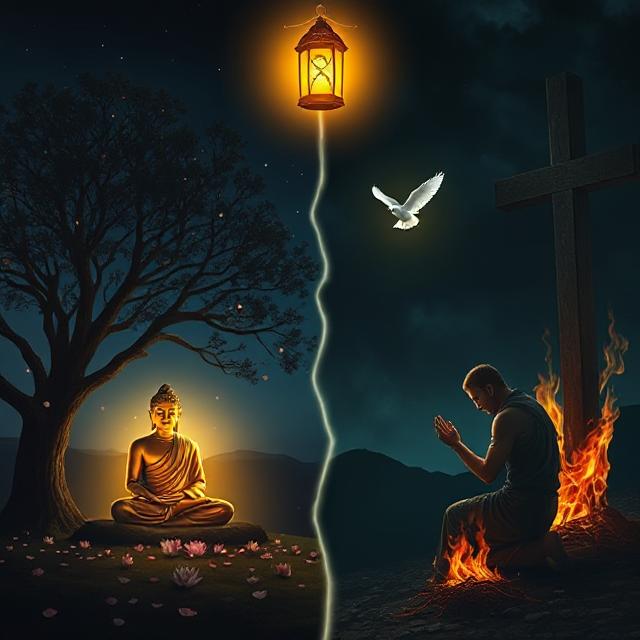
Table of Contents
Suffering in Buddhism vs Theodicy in Christianity: Why Do We Hurt?
The question of suffering has haunted every human civilization. Why do we suffer? Is there a purpose? Is it deserved, accidental, or redemptive? Suffering in Buddhism vs theodicy in Christianity reveals two distinct metaphysical frameworks—one that sees suffering as the natural result of attachment and illusion, the other that wrestles with how a loving, omnipotent God could allow pain.
Both traditions seek to answer not only why suffering happens, but also how to endure it—and ultimately, what it teaches us about reality and the self.
I. Buddhism: Suffering as the First Noble Truth
A. The Core of the Buddha’s Teaching
In Buddhism, suffering (dukkha) is not just part of life—it is life. The Buddha’s very first noble truth states:
“Life is suffering.”
This includes:
- Physical pain (birth, aging, illness, death)
- Emotional pain (loss, fear, loneliness)
- Existential suffering (impermanence, emptiness, dissatisfaction)
The central insight is that suffering arises from craving (tanha), which in turn arises from ignorance of the true nature of reality.
B. The Wheel of Samsara: Rebirth and Suffering
Suffering is not confined to one lifetime. Buddhism teaches that beings are caught in a cycle of rebirth (samsara), driven by karma. Until one achieves enlightenment (nirvana), one continues to experience suffering over countless lives.
Every desire, every aversion, every illusion binds the soul to another round of suffering.
Liberation is not achieved by divine grace but by self-awareness and ethical discipline.
C. The Path to Liberation
The cure for suffering lies in the Eightfold Path, which includes:
- Right understanding
- Right intention
- Right speech
- Right action
- Right livelihood
- Right effort
- Right mindfulness
- Right concentration
The goal is not to explain why suffering exists from a cosmic perspective, but to end it through inner transformation.
II. Christianity: Suffering and the Problem of Evil
A. The Dilemma of Theodicy
Christianity, unlike Buddhism, is theistic. It believes in an omnipotent, omniscient, and benevolent God. This creates a philosophical problem known as theodicy:
If God is all-powerful and all-loving, why does He allow evil and suffering?
This challenge has been explored by theologians from Augustine to Aquinas to modern thinkers.
B. The Fall: Original Sin and Consequences
In Christian theology, suffering entered the world through the Fall:
- Adam and Eve disobeyed God
- Humanity became estranged from divine perfection
- Pain, death, and toil became part of the human condition
Suffering is thus not God’s will, but the consequence of human free will.
C. Redemptive Suffering
Unlike Buddhism, Christianity gives meaning to suffering. Through Christ’s crucifixion and resurrection:
- God enters into human suffering
- Pain becomes a means of redemption
- Believers are invited to “carry their cross”
As Paul writes in Romans 5:3–4:
“We glory in our sufferings, because we know that suffering produces perseverance; perseverance, character; and character, hope.”
D. Heaven and the End of Suffering
In Christian eschatology, suffering is temporary. The faithful will enter eternal joy, where:
“He will wipe every tear from their eyes. There will be no more death or mourning or crying or pain.” (Revelation 21:4)
Suffering thus becomes part of a redemptive arc—not a permanent reality.
III. Core Contrasts: A Comparative Table
| Category | Buddhism | Christianity |
|---|---|---|
| Source of Suffering | Attachment, ignorance, karma | The Fall, sin, separation from God |
| Nature of Suffering | Universal, continuous in samsara | Temporary, ultimately defeated by divine love |
| Meaning of Suffering | A condition to transcend | A test, a tool for growth, a participation in Christ’s pain |
| Resolution | Enlightenment, cessation of desire | Salvation, divine grace, afterlife in heaven |
| Divine Involvement | No creator deity—cosmic laws govern | God is active, suffering is part of His providential plan |
IV. Psychological Impacts of Each View
A. Buddhism: Freedom Through Detachment
- Encourages calmness and equanimity
- Offers tools for immediate inner peace (meditation, mindfulness)
- Risks: may appear detached or passive in face of injustice
B. Christianity: Strength Through Meaning
- Encourages endurance, hope, and trust in divine justice
- Builds a narrative of purpose in pain
- Risks: may lead to spiritualizing all suffering, discouraging intervention
V. Modern Resonances
A. Buddhism in Therapy and Self-Help
Buddhist ideas have been deeply integrated into Western psychology:
- Mindfulness-Based Stress Reduction (MBSR)
- Cognitive-behavioral therapies that address craving and aversion
- Letting go as a therapeutic technique
Buddhism’s approach to suffering fits well with secular introspection and therapeutic neutrality.
B. Christianity in Social Justice and Community
Christian traditions have inspired:
- Hospitals and charities
- Liberation theology
- Martyrdom and moral protest
The personal God of Christianity is invoked as a source of hope for justice, healing, and community renewal.
VI. Can the Two Views Be Reconciled?
Though seemingly at odds, some scholars and mystics see complementarity:
- Buddhism offers tools to escape suffering through self-awareness
- Christianity offers narratives to endure suffering with meaning
Both encourage compassion, humility, and transcending the ego. In a pluralistic age, many seekers draw from both traditions—finding peace in the present moment (Buddhism) while holding onto faith in a loving future (Christianity).
Conclusion: Two Lamps for the Same Night
Suffering in Buddhism vs theodicy in Christianity reveals not just doctrinal divergence, but different emotional responses to the human condition. Buddhism teaches that liberation comes through extinguishing desire. Christianity teaches that love endures suffering and redeems it.
One path lets go of the self to dissolve pain; the other embraces pain in trust that it will one day be healed. Each holds a mirror to the human soul—and a torch in the dark.
